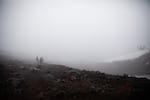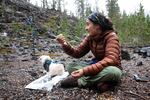
From left, Neal Ludevig, Marcela Fernandez and Aaron Hartz hike next to snowfields on South Sister in Central Oregon, Sunday, Oct. 18, 2020. The Oregon Glaciers Institute organized a funeral for the Clark Glacier after declaring it dead earlier in the summer.
Bradley W. Parks / OPB
Conditions deteriorated Sunday as wind roared in from the west atop South Sister in Central Oregon, turning back previously optimistic climbers.
Among them were three people planning to pay last respects to Clark Glacier, which a newly formed research group has declared dead.
Aaron Hartz, who led Sunday’s climb, and Anders Carlson started the Oregon Glaciers Institute, or OGI, in May 2020. They spent the summer performing health checks on the state’s glaciated regions. An August survey of the Clark Glacier turned up no glacier at all.
“For something to be a glacier, the ice needs to be deforming and flowing under its own weight,” Hartz said. “When that ceases to happen, it’s really just like a dead ice body.”
No single agency — local, state or federal — is responsible for monitoring glacial health in Oregon, so little is known about how they’re faring.
Hartz and Carlson started OGI to raise public awareness of Oregon’s glaciers and their health. The group estimates Oregon has about 40 named glaciers remaining across Mount Hood, Mount Jefferson, each of the Three Sisters, Broken Top, Mount Thielsen and the Wallowas — and they’re not doing great.

OGI president Anders Carlson held a funeral for the Clark Glacier in front of the Oregon Capitol on Sunday, Oct. 18, 2020.
Bradley W. Parks / OPB
Oregon’s glaciers are shrinking. And that has perilous consequences for the environment, the economy and culture.
Glaciers are basically frozen rivers moving downhill. They affect the quality, quantity, temperature and timing of freshwater. In other words, these frozen rivers impact our non-frozen rivers.
The Nooksack Tribe of northwest Washington published research in 2013 that warned glacial ablation could drive some salmon and other fish species to extinction in the Nooksack River, ultimately leading to the destruction of the tribe’s way of life.
“The extinction of salmonids from the Nooksack River is unacceptable to the Tribe since it is dependent on these species," the study reads, “and the Tribe is place-based and cannot relocate to areas where salmon will survive.”
Glaciers also affect wildfire. Smaller glaciers mean less meltwater, which can strap soil for moisture. Were it not for Oregon’s remaining glaciers, Carlson asserted, wildfires that hit the state this season, particularly the Beachie Creek and Holiday Farm fires, could have been more catastrophic than they were.
Related: We know climate change set the conditions for Oregon fires. Did it stoke the flames, too?
“It was the worst ever and it could have been worse,” he said.
Losing a glacier is a big deal.
A glacier “dies” when a number of vital signs are no longer present. Scientists check for things like crevasses, which are giant cracks in the ice that form as a glacier moves, or convex edges, which can signal advancement.
Carlson compared seeing a dead glacier to seeing a dead deer.
“A living deer moves. It breathes, it eats, it poops,” Carlson said. “A dead deer is its carcass rotting on the landscape.” You can see some fur, bones, maybe a face and antlers, but the deer is dead.
A dead glacier still might have some snow, ice and meltwater, but you can tell when it’s gone.

Marcela Fernandez holds crystals from other glaciers she's visited Sunday, Oct. 18, 2020.
Bradley W. Parks / OPB
Wind and rain kept Sunday’s climbing group from the icy patches that remain of Clark Glacier, so they settled for a rigorous hike followed by a moment of silence just off the trailhead parking lot. Another gathering, led by Carlson, held a funeral for Clark Glacier on the much sunnier steps of the Oregon Capitol.
“It’s really important to give tribute and honor to the fact that, yes, they’re leaving, but we need to say goodbye to them and thank them for their existence as we do with a human being,” said Marcela Fernandez, who advocates for preserving tropical glaciers and joined Sunday’s climb.
Carlson stressed the importance of humans improving our relationship to Oregon’s remaining glaciers, learning about them and caring for them.
Glaciers contribute to irrigation water used to grow the food we eat, the water we drink, the lakes and rivers we recreate in. And they form the glittering edge of the Northwest’s mountainous landscapes.
“We gotta see ourselves as part of nature, rather than trying to save it,” Carlson said. By losing a glacier, he added, “I’m losing a part of myself.”
